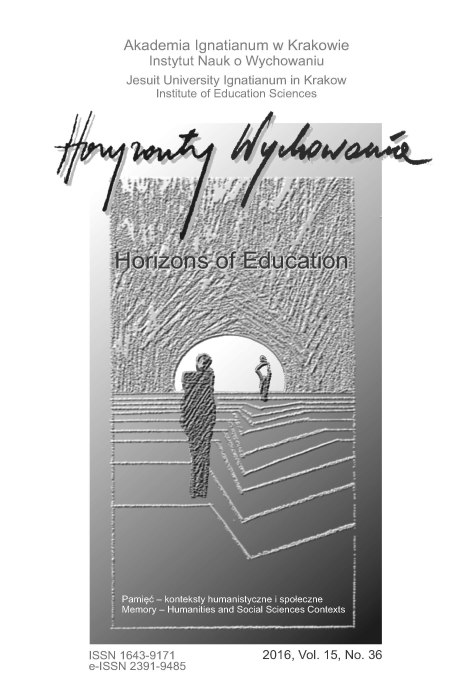Forming Impressions of Personality – An Essential or Detrimental Process? An Overview of Research Reports and Practical Implications
Abstract
Research Objective: The aim of this article is to refer novel research on impression formation and halo effect outcomes to the classical series of experiments conducted by Solomon Asch in 1946. In Asch’s article presenting these experiments several theories and ideas are outlined and they are cited and broadened today by social cognition psychologists.
The Research Problem and Methods: The article provides a critical overview of scientific research concerning the process of impression formation. The analysis of these research outcomes enabled to show Solomon Asch’s theories in an updated light.
The Process of Argumentation: In the first part of this paper an influence of central features, mainly “warmth” and “coldness” is being discussed. In the second part outer factors, such as the sequence of learning the features, affective influences and the length of acquaintance with an evaluated person are being discussed in the context of forming an impression of a person. In the third part the phenomenon of the relativity of the attributes’ sense depending on co-existing features is being described.
Research Results: Experiments presented in the paper confirm Asch’s observations and support the thesis that the general impression influences the perception of particular features of a person. People are not aware of the existence of this phenomenon.
Conclusions, Innovations and Recommendations: The outcomes of research discussed in the paper have several practical implications for people evaluating by profession, such as teachers, recruiters or jurors and for the people who are being evaluated. They should be aware of the distortions made by automatic impression formation concerning personality or competences of other people and they ought to realize that surrendering to such an automatic mechanism can make an evaluator responsible for the fate of the evaluated person in context of their school or professional career.References
Asch, S.E. (1946). Forming impressions of personality. The Journal of Abnormal and Social Psychology, 41(3), 258-290.
Balzer, W.K. i Sulsky, L.M. (1992). Halo and performance appraisal research: a critical examination. Journal of Applied Psychology, 77(6), 975-985.
Dennis, I. (2007). Halo effects in grading student projects. Journal of Applied Psychology 92(4), 1169-1176.
Fiske, A.P. (1991). Structures of social life: The four elementary forms of human relations: Communal sharing, authority ranking, equality matching, market pricing. New York: Free Press.
Forgas, J.P. (2011). She just doesn’t look like a philosopher…? Affective influences on the halo effect in impression formation. European Journal of Social Psychology, 41, 812-817.
Goldman, M., Cowles, M.D. i Florez, C.A. (1983). The halo effect of an initial impression upon speaker and audience. The Journal of Social Psychology, 120, 197-201.
Jacobs, R. i Kozlowski, S.W.J. (1985). A closer look at halo error in performance ratings. Academy of Management Journal, 28(1), 201-212.
Kervyn, N., Bergsieker, H.B., Grignard, F. i Yzerbyt, V.Y. (2016). An advantage of appearing mean or lazy: Amplified impressions of competence or warmth after mixed descriptions. Journal of Experimental Social Psychology, 62, 17-23.
Landy, D. i Sigall, H. (1974). Beauty is talent: Task evaluation as a function of the performer’s physical attractiveness. Journal of Personality and Social Psychology, 29, 299-304.
Madera, J.M., Hebl, M.R. i Martin, R.C. (2009). Gender and letters of recommendation for academia: Agentic and communal differences. The Journal of Applied Psychology, 6, 1591-1599.
Moskowitz, G.B. (2009). Zrozumieć siebie i innych. Psychologia poznania społecznego. Gdańsk: Gdańskie Wydawnictwo Psychologiczne.
Naquin, C.E. i Tynan, R.O. (2003). The team halo effect: why teams are not blamed for their failures. Journal of Applied Psychology, 88(2), 332-340.
Nisbett, R.E. i DeCamp Wilson, T. (1977a). Telling more than we can know: verbal reports on mental processes. Psychological Review, 84(3), 231-259.
Nisbett, R.E. i DeCamp Wilson, T. (1977b). The halo effect: evidence for uncon-scious alteration of judgments. Journal of Personality and Social Psychology, 35(4), 250-256.
Solomonson, A.L. i Lance, C.E. (1997). Examination of the relationship between true halo and halo error in performance ratings. Journal of Applied Psychology, 82(5), 665-674.
Srivastava, S., Guglielmo, S. i Beer, J.S. (2010). Perceiving others’ personalities: examining the dimensionality, assumed similarity to the self, and stability of perceiver effects. Journal of Personality and Social Psychology, 98(3), 520-534.
Thorndike, E.L. (1920). A constant error in psychological ratings. Journal of Applied Psychology, 4(1), 25-29.
Walker Naylor, R. (2007). Nonverbal cues based first impressions: Impression formation through exposure to static images. Marketing Letters, 18, 165-179.
Copyright (c) 2017 HORIZONS OF EDUCATION

This work is licensed under a Creative Commons Attribution-NonCommercial-NoDerivatives 4.0 International License.
Authors who publish in this journal agree to the following terms:
- Authors retain the copyright to their work while granting the journal the right of first publication. The work will be simultaneously licensed under a CC BY-ND license, which permits others to share the work with proper credit given to the author and the original publication in this journal.
- Authors may enter into additional, non-exclusive agreements for the distribution of the published version of the work (e.g., posting it in an institutional repository or publishing it in another journal), provided that the original publication in this journal is acknowledged.
We allow and encourage authors to share their work online (e.g., in institutional repositories or on personal websites) both before and during the submission process, as this can foster beneficial exchanges and lead to earlier and increased citations of the published work. (See The Effect of Open Access). We recommend using any of the following academic networking platforms:





